2012 PEUGEOT 4007 tyre pressure
[x] Cancel search: tyre pressurePage 22 of 236
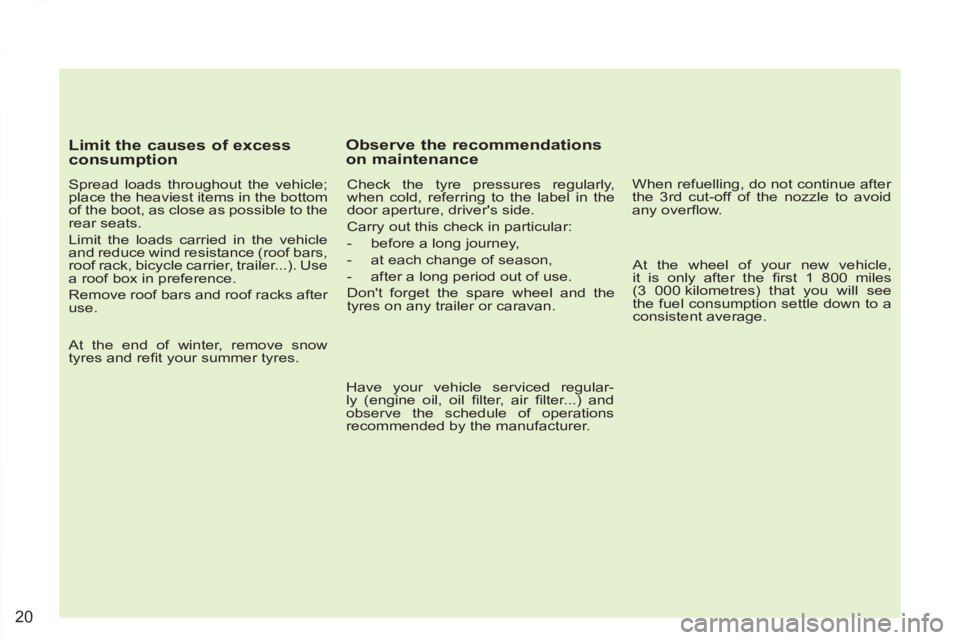
20
Limit the causes of excess
consumption
Spread loads throughout the vehicle;
place the heaviest items in the bottom
of the boot, as close as possible to the
rear seats.
Limit the loads carried in the vehicle
and reduce wind resistance (roof bars,
roof rack, bicycle carrier, trailer...). Use
a roof box in preference.
Remove roof bars and roof racks after
use.
At the end of winter, remove snow
tyres and refi t your summer tyres.
Observe the recommendations
on maintenance
Check the tyre pressures regularly,
when cold, referring to the label in the
door aperture, driver's side.
Carry out this check in particular:
- before a long journey,
- at each change of season,
- after a long period out of use.
Don't forget the spare wheel and the
tyres on any trailer or caravan.
Have your vehicle serviced regular-
ly (engine oil, oil fi lter, air fi lter...) and
observe the schedule of operations
recommended by the manufacturer.
When refuelling, do not continue after
the 3 rd cut-off of the nozzle to avoid
any overfl ow.
At the wheel of your new vehicle,
it is only after the fi rst 1 800 miles
(3 000 kilometres) that you will see
the fuel consumption settle down to a
consistent average.
Page 105 of 236
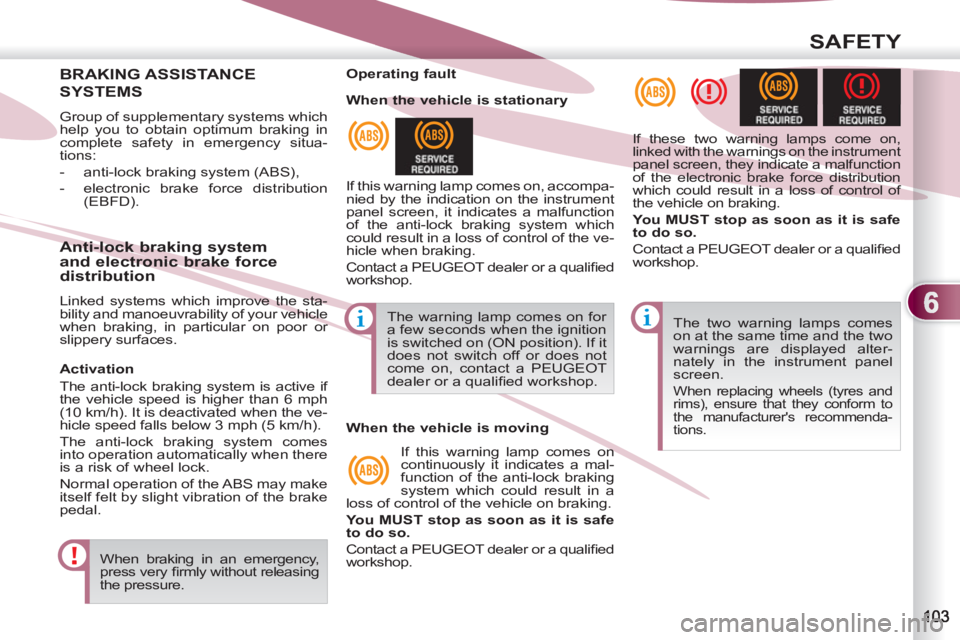
6
SAFETY
BRAKING ASSISTANCE
SYSTEMS
Group of supplementary systems which
help you to obtain optimum braking in
complete safety in emergency situa-
tions:
- anti-lock braking system (ABS),
- electronic brake force distribution
(EBFD).
When braking in an emergency,
press very fi rmly without releasing
the pressure. The two warning lamps comes
on at the same time and the two
warnings are displayed alter-
nately in the instrument panel
screen.
When replacing wheels (tyres and
rims), ensure that they conform to
the manufacturer's recommenda-
tions.
Operating fault
If this warning lamp comes on, accompa-
nied by the indication on the instrument
panel screen, it indicates a malfunction
of the anti-lock braking system which
could result in a loss of control of the ve-
hicle when braking.
Contact a PEUGEOT dealer or a qualifi ed
workshop. If these two warning lamps come on,
linked with the warnings on the instrument
panel screen, they indicate a malfunction
of the electronic brake force distribution
which could result in a loss of control of
the vehicle on braking.
You MUST stop as soon as it is safe
to do so.
Contact a PEUGEOT dealer or a qualifi ed
workshop.
Anti-lock braking system
and electronic brake force
distribution
Linked systems which improve the sta-
bility and manoeuvrability of your vehicle
when braking, in particular on poor or
slippery surfaces. The warning lamp comes on for
a few seconds when the ignition
is switched on (ON position). If it
does not switch off or does not
come on, contact a PEUGEOT
dealer or a qualifi ed workshop.
When the vehicle is stationary
When the vehicle is moving
If this warning lamp comes on
continuously it indicates a mal-
function of the anti-lock braking
system which could result in a
loss of control of the vehicle on braking.
You MUST stop as soon as it is safe
to do so.
Contact a PEUGEOT dealer or a qualifi ed
workshop.
Activation
The anti-lock braking system is active if
the vehicle speed is higher than 6 mph
(10 km/h). It is deactivated when the ve-
hicle speed falls below 3 mph (5 km/h).
The anti-lock braking system comes
into operation automatically when there
is a risk of wheel lock.
Normal operation of the ABS may make
itself felt by slight vibration of the brake
pedal.
Page 122 of 236

7
DRIVING
Operating faults
If the selected transmission mode display
fl ashes, the vehicle switches automati-
cally to front "2WD"
transmission mode.
It is then no longer possible to select the
transmission mode using the control A
. Do not subject the vehicle to ex-
cessive conditions while driving.
As the engine torque is applied
to all four wheels, the condition
of the tyres has a considerable
impact on the performance of
the vehicle.
Ensure that all four tyres are in
good condition.
Avoid driving the vehicle in
sandy or muddy areas or in
other areas in which the wheels
could spin.
Spinning the wheels places the
transmission components under
pressure and could cause a seri-
ous malfunction.
Do not drive the vehicle through
deep water.
Avoid driving over excessively
uneven terrain (risk of scraping
under the body or of grounding
on crossing a bridge).
Have your vehicle towed on a
fl atbed.
The vehicle must not be towed
with the front or rear wheels on
the ground even if it is in front
"2WD" (2 wheel drive) mode.
If the message "SLOW DOWN" is dis-
played on the instrument panel, let the
transmission cool down then wait for the
display to clear before setting off again.
If "4WD" and "LOCK" are displayed
alternately and if "MAINTENANCE
REQUIRED" is displayed in the instru-
ment panel, the system has failed and
the safety system has been activated.
Contact a PEUGEOT dealer or a quali-
fi ed workshop without delay.
Page 138 of 236
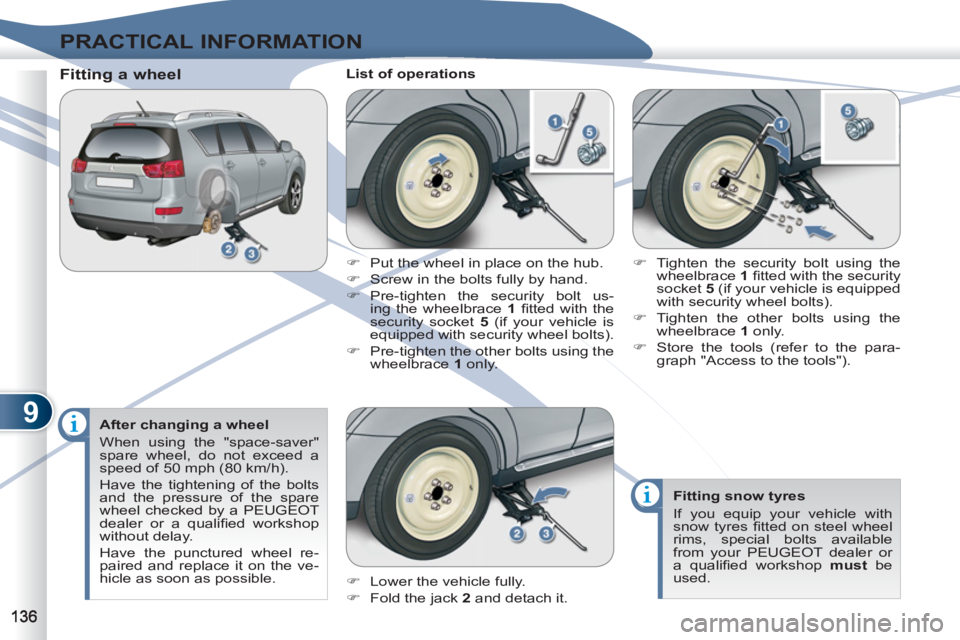
9
PRACTICAL INFORMATION
After changing a wheel
When using the "space-saver"
spare wheel, do not exceed a
speed of 50 mph (80 km/h).
Have the tightening of the bolts
and the pressure of the spare
wheel checked by a PEUGEOT
dealer or a qualifi ed workshop
without delay.
Have the punctured wheel re-
paired and replace it on the ve-
hicle as soon as possible.
Fitting a wheel
List of operations
�)
Lower the vehicle fully.
�)
Fold the jack 2
and detach it.
�)
Tighten the security bolt using the
wheelbrace 1
fi tted with the security
socket 5
(if your vehicle is equipped
with security wheel bolts).
�)
Tighten the other bolts using the
wheelbrace 1
only.
�)
Store the tools (refer to the para-
graph "Access to the tools").
Fitting snow tyres
If you equip your vehicle with
snow tyres fi tted on steel wheel
rims, special bolts available
from your PEUGEOT dealer or
a qualifi ed workshop must
be
used.
�)
Put the wheel in place on the hub.
�)
Screw in the bolts fully by hand.
�)
Pre-tighten the security bolt us-
ing the wheelbrace 1
fi tted with the
security socket 5 (if your vehicle is
equipped with security wheel bolts).
�)
Pre-tighten the other bolts using the
wheelbrace 1
only.
Page 156 of 236

9
PRACTICAL INFORMATION
TOWING A TRAILER, CARAVAN, WING A TRAILER, CARAVA
ETC.
Driving advice
The maximum towing load on a long
slope depends on the gradient and the
outside temperature.
In all cases, pay attention to the coolant
temperature.
Side wind
�)
Take into account the increased
sensitivity to side wind.
Cooling
Towing a trailer on a slope increases
the temperature of the coolant.
As the fan is electrically controlled, its
cooling capacity is not dependent on
the engine speed.
�)
To lower the engine speed, reduce
your speed.
Braking
Towing a trailer increases the braking
distance.
Tyres
�)
Check the tyre pressures of the tow-
ing vehicle and of the trailer, observ-
ing the recommended pressures.
Lighting
�)
Check the lighting and signalling on
the trailer.
�)
If this message is dis-
played, stop your ve-
hicle as soon as it is
safe to do so.
If the message fl ashes slowly, wait for
the engine to cool before topping up the
level, if necessary.
If the message fl ashes rapidly, contact
a PEUGEOT dealer or a qualifi ed work-
shop without delay.
Opening of the lower tailgate is
prohibited if a towbar is being
used.
We recommend the use of gen-
uine PEUGEOT towbars and
their harnesses that have been
tested and approved from the
design stage of your vehicle and
that the fi tting of the towbar is
entrusted to a PEUGEOT dealer
or a qualifi ed workshop.
If the towbar is not fi tted by a
PEUGEOT dealer, it is impera-
tive that it is fi tted using the
electrical pre-equipment located
at the rear of the vehicle and in
accordance with the manufac-
turer's instructions.
Driving with a trailer subjects the
towing vehicle to more signifi -
cant stress and its driver must
be particularly careful.
Your vehicle is primarily designed for
transporting people and luggage, but it
may also be used for towing a trailer.
Distribution of loads
�)
Distribute the load in the trailer so
that the heaviest items are as close
as possible to the axle and the nose
weight approaches the maximum
permitted without exceeding it.
Air density decreases with altitude, thus
reducing engine performance. Above
1 000 metres, the maximum towing
load must be reduced by 10 % of the
GTW and so on for every 1 000 metres
of altitude.
Refer to the "Technical Data" section for
details of the weights and towing loads
which apply to your vehicle.
Page 162 of 236
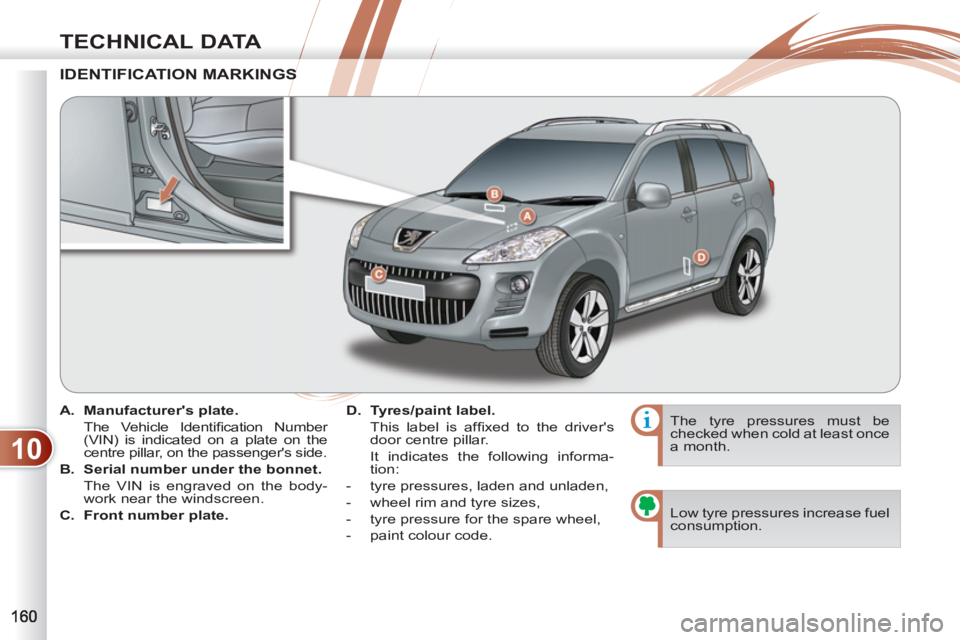
10
TECHNICAL DATA
A.
Manufacturer's plate.
The Vehicle Identifi cation Number
(VIN) is indicated on a plate on the
centre pillar, on the passenger's side.
B.
Serial number under the bonnet.
The VIN is engraved on the body-
work near the windscreen.
C.
Front number plate.
D.
Tyres/paint label.
This label is affi xed to the driver's
door centre pillar.
It indicates the following informa-
tion:
- tyre pressures, laden and unladen,
- wheel rim and tyre sizes,
- tyre pressure for the spare wheel,
- paint colour code. The tyre pressures must be
checked when cold at least once
a month.
IDENTIFICATION MARKINGSS
Low tyre pressures increase fuel
consumption.
Page 224 of 236
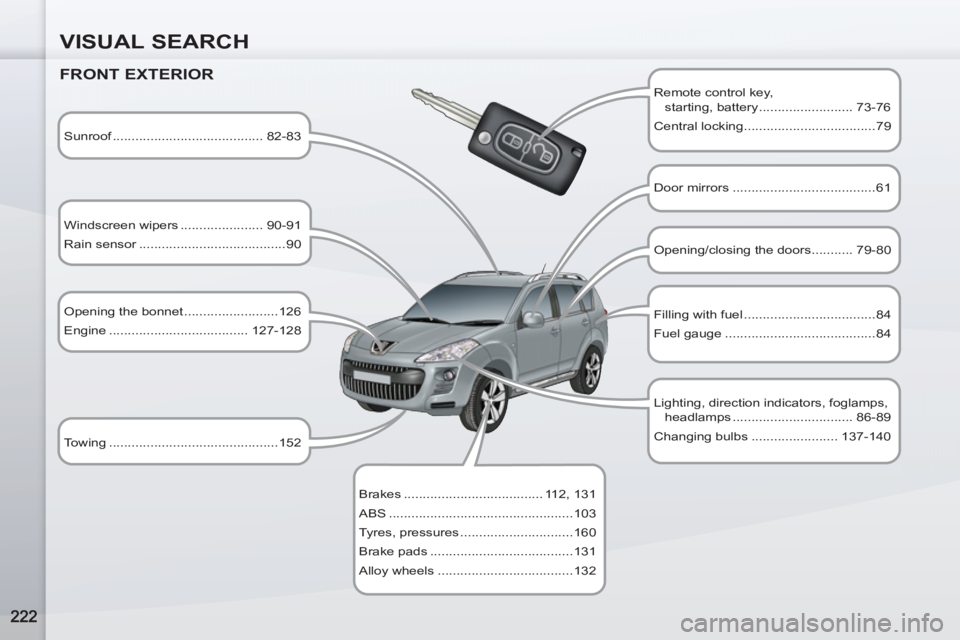
VISUAL SEARCH
FRONT EXTERIOR
Remote control key,
starting, battery ......................... 73-76
Central locking ...................................79
Sunroof ........................................ 82-83
Windscreen wipers ...................... 90-91
Rain sensor .......................................90
Opening the bonnet .........................126
Engine ..................................... 127-128
Towing .............................................152
Door mirrors ......................................61
Opening/closing the doors ........... 79-80
Filling with fuel ...................................84
Fuel gauge ........................................84
Lighting, direction indicators, foglamps,
headlamps ................................ 86-89
Changing bulbs ....................... 137-140
Brakes ..................................... 112, 131
ABS .................................................103
Tyres, pressures ..............................160
Brake pads ......................................131
Alloy wheels ....................................132
Page 225 of 236

VISUAL SEARCH
REAR EXTERIOR
3rd brake lamp ................................141
Tailgate ........................................ 80-81
Rear wiper .........................................91
Spare wheel, jack, changing,
fi tting ..................................... 132-136
Lower tailgate ....................................81
Towbar .............................................154
Rear parking
sensors ................................. 123-124
Towing .............................................152
Rear lamps, direction indicators,
foglamps ................................... 86-89
Changing bulbs ....................... 141-143
Door mirror ........................................61
Side repeaters .................................140
Opening/closing the doors ........... 79-80
Brakes ..................................... 112, 131
ABS .................................................103
Tyres, pressures ..............................160
Brake pads ......................................131
Alloy wheels ....................................132
Accessories .....................................156
Roof bars .........................................155